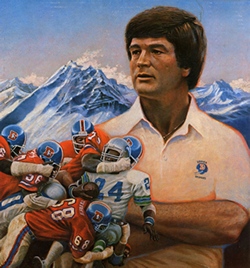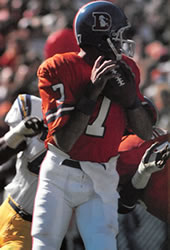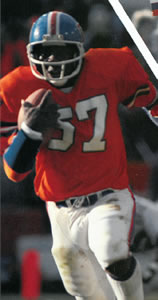 KNOW YOUR 1980s DENVER BRONCOS
KNOW YOUR 1980s DENVER BRONCOS
This week, Head Coach Dan Reeves.

From my beloved 1982 Broncos yearbook, a glorious UNCREDITED (!) painting of giant Coach Reeves surveying the entire team tackling a hapless Seahawks player. Behind him, the majestic Rocky Mountains*.
Remaining editions of KY1980sDBs: 2.
Dan was hired as head coach of the Broncos before the 1981 season, at age 37, the youngest head coach in the league at the time. He succeeded the successful (but not successful enough!) Red Miller, and there should be a league rule mandating that there is always at least one head coach named “Red.” Dan came along at the right time, just two years before the Broncos obtainedJohn Elway, and Coach Reeves got to spend the rest of his tenure relying on one of the greatest quarterbacks in NFL history. Dan’s approach was to base his offense on a strong running game, defense, and conservative play calling. This occasionally led to spats with his star quarterback and Broncos fans, who felt that his approach didn’t suit the talents of the team at the time. Nevertheless, a football coach is charged with winning games, and Dan did that, compiling a 110-73 record (a .601 winning percentage) over his 12 years with the team, winning the division six times and making it to the Super Bowl three times. After a mediocre 1992 season, and a perception that more success may be found going in another direction, Dan was fired by the Broncos. He coached for another 11 years for the New York Giants, then the Atlanta Falcons. In 1993 and 1998, once with each of those teams, he was named AP NFL Coach of the Year.
He coached in Super Bowl XXI, in which the Broncos were pummeled by the New York Giants 39-20, Super Bowl XXII, in which the Broncos were pummeled by the Washington Native Americans 42-10, and Super Bowl XXIV, in which the Broncos were pummeled by the San Francisco 49ers 55-10. Dan later led the Atlanta Falcons to Super Bowl XXXIII, in which his team was pummeled by the Mike Shanahan-led Broncos, 34-19.
So what makes Dan Reeves so awesome? Despite his overconservative coaching reputation, Dan managed to consistently adapt and succeed as the Broncos’ coach. As one example of his adaptability, he was willing to hand some playcalling duties to John Elway when the quarterback was in his prime. Though the two often clashed, Dan’s mentoring helped turn John into the great player he became. Dan’s leadership guided the Broncos to three 1980s Super Bowls, and despite the team’s pummelings on the biggest stage, it cemented the franchise as one of the consistently best in the NFL.
These days, at 66 years old, Dan serves as a broadcaster for the Westwood One radio network. He has shown interest in returning to the sidelines since his tenure with the Falcons ended in 2003. He briefly served as a consultant for the Dallas Cowboys, has interviewed with the San Francisco 49ers, and has implied he would like to work with current Buffalo Bills’ coach Chan Gailey, whom he had coached as a youth player.
*This picture is almost as good. He looks like Clark Kent about to enter a phone booth.



